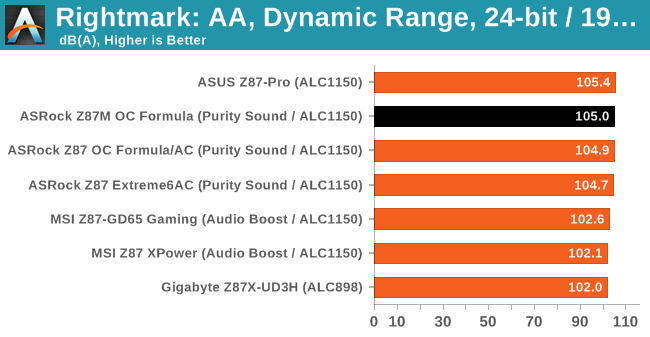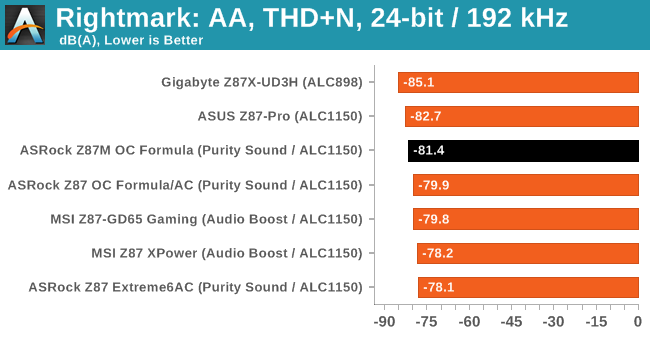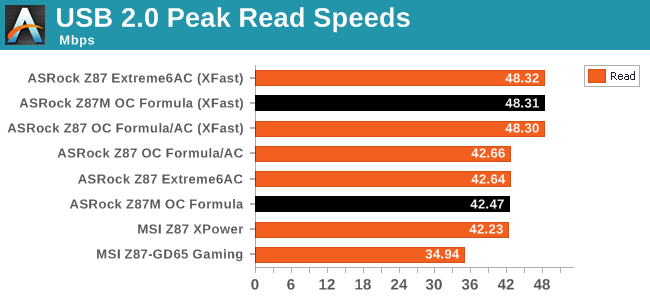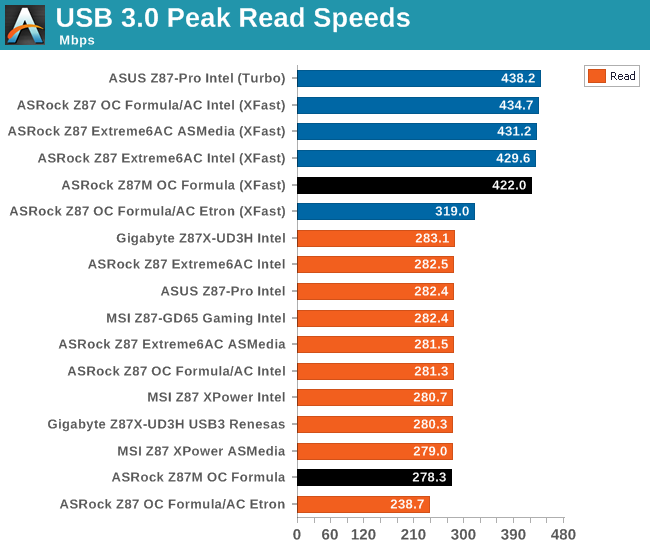ASRock Z87M OC Formula Review: mATX OC at $190
by Ian Cutress on August 14, 2013 10:00 AM EST- Posted in
- Motherboards
- ASRock
- Haswell
- Z87
System Benchmarks
Rightmark Audio Analyzer 6.2.5
In part due to reader requests, we are pleased to include Rightmark Audio Analyzer results in our benchmark suite. The premise behind Rightmark:AA is to test the input and output of the audio system to determine noise levels, range, harmonic distortion, stereo crosstalk and so forth. Rightmark:AA should indicate how well the sound system is built and isolated from electrical interference (either internally or externally). For this test we connect the Line Out to the Line In using a short six inch 3.5mm to 3.5mm high-quality jack, turn the OS speaker volume to 100%, and run the Rightmark default test suite at 192 kHz, 24-bit. The OS is tuned to 192 kHz/24-bit input and output, and the Line-In volume is adjusted until we have the best RMAA value in the mini-pretest. We look specifically at the Dynamic Range of the audio codec used on board, as well as the Total Harmonic Distortion + Noise.


USB Backup
For this benchmark, we run CrystalDiskMark to determine the ideal sequential read and write speeds for the USB port using our 240 GB OCZ Vertex3 SSD with a SATA 6 Gbps to USB 3.0 converter. Then we transfer a set size of files from the SSD to the USB drive using DiskBench, which monitors the time taken to transfer. The files transferred are a 1.52 GB set of 2867 files across 320 folders – 95% of these files are small typical website files, and the rest (90% of the size) are the videos used in the WinRAR test. In an update to pre-Z87 testing, we also run MaxCPU to load up one of the threads during the test which improves general performance up to 15% by causing all the internal pathways to run at full speed.


The USB speeds of the ASRock motherboards, especially using XFast, are always impressive.
DPC Latency
Deferred Procedure Call latency is a way in which Windows handles interrupt servicing. In order to wait for a processor to acknowledge the request, the system will queue all interrupt requests by priority. Critical interrupts will be handled as soon as possible, whereas lesser priority requests, such as audio, will be further down the line. So if the audio device requires data, it will have to wait until the request is processed before the buffer is filled. If the device drivers of higher priority components in a system are poorly implemented, this can cause delays in request scheduling and process time, resulting in an empty audio buffer – this leads to characteristic audible pauses, pops and clicks. Having a bigger buffer and correctly implemented system drivers obviously helps in this regard. The DPC latency checker measures how much time is processing DPCs from driver invocation – the lower the value will result in better audio transfer at smaller buffer sizes. Results are measured in microseconds and taken as the peak latency while cycling through a series of short HD videos - under 500 microseconds usually gets the green light, but the lower the better.

Similarly to other Haswell motherboards, DPC Latency on the platform seems to be higher than that seen on Ivy Bridge, with 150-200 being the norm rather than the sub-100 we were kind of expecting.










25 Comments
View All Comments
psyside1 - Friday, August 23, 2013 - link
Don't bother with other boards, if you can get ROG, period.Synomenon - Wednesday, August 14, 2013 - link
Did the specific board Anandtech tested have a C1 or C2 Z87 chipset?QChronoD - Thursday, August 15, 2013 - link
I'm disappointed about the copy/paste of the HDMI In from the last review, especially with the lame excuse of being unable to test it due to not owning a console. Seeing as how he is most likely writing the review about this motherboard on a different computer, is it really that difficult to use it as a source and do some basic testing? Do you have to use the CPU graphics to be able to switch to it? Does the HDMI In work well with multiple displays? If you have dual monitors, is it possible to control which one gets switched to the external input?nitemareglitch - Friday, August 16, 2013 - link
Anyone think this looks like the old DFI motherboards?PC Perv - Saturday, August 17, 2013 - link
The lack of enthusiasm on this review is.. palpable. ^^ Can't really blame the reviewer, to be frank. It is a shame that mobo makers are throwing everything but the kitchen sink, which are largely unfinished and useless, in order to justify overpriced Intel boards.In light of ASrock's emphasis of overclocking capability ("OC Formula"), I find the AT's overclocking verification process to be awfully inadequate. No serious overclocker will consider a POV Ray run and an unidentified OCCT run as proof of successful overclock.
One more nitpick is that Video/Audio-IN via HDMI was not tested. It seems like the most interesting feature among the bazillion junks ASrock dumped in this board. The reviewer is candid about it, which I appreciate, but it still doesn't make the review complete since the rest of stuff is not very interesting (and it is unclear whether they even work without hitches, since they were not tested) and, as aforementioned, the board's OC-ability wasn't really "tested."
So after reading this review, the board seems like a today's average board, which comes with lots of useless and half-baked features that simply fill in the questionable checkboxes.